Enneagram Types and the Wisdom of the Enneagram
Date 8/31/2025
Explore More:
Psyche Personal Growth eBook
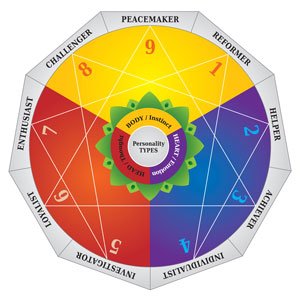

The Enneagram is a profound tool that reveals the psychological patterns that limit our consciousness, leading to our greatest sufferings and most destructive behaviors, but it is also the most effective and clear the roadmap for uncovering our gifts and finding inner freedom. It describes nine basic, interrelated ways of experiencing one’s own identity and of relating to the world. Our Enneagram type is not just a cluster of contrasting positive and negative traits, but a rich and layered map of articulating the needs and qualities most intimately associated with the core of our sense of self as well as the misguided ways we attempt to express ourselves from a place of rage, shame, and fear.
Meaning of the Enneagram
The Enneagram challenges us to go beyond a merely intellectual understanding of our inner life and to discard what we think we know about ourselves. To see our Enneagram type with accuracy and to benefit from it requires time, practice, and inner work.
Everyone has a core type, which stays fixed throughout one’s life and does not change. Within each type, however, there are a wide range of behaviors and motivations that stem from how present, liberated, and conscious we are or how “asleep” and lost we are in the compulsive expressions of our type. This means that two people can be the same type but manifest it in vastly different ways. Along with our core type, there are many other distinctions that, when all accounted for, make what seem a rather limited number of personalities quite numerous, like the Instinctual Drives, the wings, Tri-Fixation, and more.
Origins of the Enneagram
The word “enneagram” simply means a diagram of nine in Greek. It’s a geometric symbol composed of nine points around a circle, each point connected by lines to two other points. It was first introduced to the world as a representation of esoteric principles by inner work teacher G.I. Gurdjieff (circa 1860-1949). His teaching of the Enneagram had nothing to do with personality types. Later, it was Bolivian mystic Oscar Ichazo that used Gurdjieff’s Enneagram to synthesize many ancient systems of understanding human nature with modern psychological insights. Today, the Enneagram has come to be most widely known and used as a system of character types.

Essence and Personality
Though Gurdjieff’s Enneagram did not refer to personality, a central facet of his teachings was the relationship between essence and personality. Generally speaking, when someone says “personality type,” we think we know what that means. “Personality” is a term we use to describe our character and identity, but in the context of the Enneagram, personality refers to something much more specific. The personality is the way that our temperamental and hereditary traits become crystallized into patterns as well as the dynamics by which these patterns continue to be reinforced.
When we are not conscious of ourselves, these patterns become automatic and habitual to the point where they come to dominate our experience of who we are. We become identified with our personality. In other words, we believe that we are our personality, it’s desires, motivations, and fears, and we lose sight of what our identity could be that isn’t just a pattern. The personality is an important part of us, but it’s not the whole story. “Ego” is the term that represents the identification with personality. When we believe we are our personality, our essence goes unrecognized and unintegrated.
Essence, Gurdjieff claimed, is what is inherent in us and characterizes our authentic identity. From a spiritual perspective, essence could be thought of not as our “soul”, but rather our potential for a soul. Essence is our potential for an awakened consciousness that makes up our inner nature, but it requires maturation and development via inner work and the effort to be present. When we make an effort to be present, as in meditation for example, it is essence that can be present. If we have an interest in “waking up,” it is essence that we are trying to awaken.
To sustain our capacity to be present requires that we become less identified with our personality by becoming more conscious and aware of its patterns and habits. The aim of Enneagram work is therefore not to overcome or transcend the personality, but to be so present with it that we see it for what it is - a structure and not our true self. This is how we shift our identity from the psychological activity of the personality into the simple awareness and sensitivity that characterizes essence.
Essence isn’t vague or lacking distinction. It has qualities, and the core of each point on the Enneagram represents a specific quality of essence. They can be felt kind of like flavors of presence, and the more we learn to be ongoingly present, the more substantial the experience of the qualities of essence becomes. Essential qualities are what give our lives a real sense of color, value, and meaning. Essential qualities are not fixed or concrete, so all names for them are merely guideposts and shouldn’t be taken too literally.

Enneagram Numbers and Their Essence
Essence One – Integrity: The quality of presence as an alignment with something greater than our individual experiences, as a perception that there is an objective order behind things.
Essence Two – Love: The quality of presence that is an experience of everything as cherished, held, and cared for.
Essence Three – Value: The felt sense that everyone and everything is precious and valuable in and of itself
Essence Four – Depth: The perception that presence itself has inexhaustible dimensionality and indeterminate mystery.
Essence Five – Insight: The vivid perception of reality unfolding itself in fresh and novel ways moment by moment.
Essence Six – Truth: The sense of presence as being fundamental and authentically real, it is the sense of what makes something feel real and true.
Essence Seven – Freedom: The recognition that essence is not conditional on anything else nor determined by anything.
Essence Eight – Power: The substantial, vivid, and alive quality of presence.
Essence Nine – Harmony: The experience of each aspect of our experience fully expressing itself, interwoven and congruous in a way the ego can’t usually perceive.
When we are centered and present, we can feel these qualities as the core of our presence. Unfortunately, most of us are present very rarely and only for fleeting moments, so we overlook essence and become preoccupied with our ego’s agenda all over again. One can view each Enneagram type as having a kind of faint impression of its respective essential quality, but instead of cultivating a connection with it by practicing being present to, our attention is caught by the activity of the ego in a misguided attempt to unlock these qualities through the desires and goals of our personality. The ego-based activity of trying to get to essence is what puts us “asleep” to essence in the first place. This only leaves us deeply frustrated and investing our energies into things that ultimately end up furthering an estrangement from our deeper nature.
As well-known Sufi aphorism speaks to: We need to be “in the world, but not of it,” as in, to fulfill the demands of daily life with keeping attention on essence. How do we learn to cultivate a deeper and more robust capacity to be present to essence? The work of helping us to ongoingly remember ourselves as essence is what the Enneagram is most useful for.
Enneagram Centers of Intelligence: Body, Heart, and Mind
The place to begin the path of self-remembering with the Enneagram is with the centers of intelligence: the body, the heart, and the mind, as mentioned above. The centers are the backbone of the Enneagram types that represent different kinds of perception, of knowing ourselves, and of experiencing the world. The reason there are nine Enneagram types is because they result from nine different configurations of the three centers, with each type representing a kind of specialization on a theme based in one of the centers.
Three Enneagram types are rooted in the body, three in the heart, and three in the mind. This means that their attention and energy is organized around issues rooted in these centers.

Eight, Nine, and One are Enneagram Body Types. Their focus, strengths, and liabilities derive from issues related to the body: the sense of aliveness, psychological boundaries, and our sense of worthiness to take up space in the world.
We experience our body through the “language” of physical sensation which makes us aware of “life force.” When we are present to the body, we feel a sense of immediacy, vitality, and groundedness. Our innate somatic wisdom is a readily available resource, taking us out of our heads to provide an in-the-moment felt sense of ourselves.
When we’re not in touch with the body, the ego compensates by reinforcing ego-boundaries fortified by anger that we either compulsively over-assert, in the style of Type Eight, that we dissociate from, in the style of Type Nine, or we tense up, constricting ourselves in frustration, in the style of Type One.

Types Two, Three, and Four are Enneagram Heart Types. While most of us think of the heart as little more than the source of our feelings, the heart is the center in us where we feel our sense of identity, where we experience our values, and where we make authentic contact with others.
For example, we can behave in ways that are in or out of alignment with our sense of identity. We could take on a job or enter a relationship that may compromise our values and push away from listening to how that misalignment is impacting our sense of self. We can bury the wisdom from our heart. In time, we will hopefully come to a place where we can’t deny what our heart’s knowing such that we can find some way to make our external life more reflective of our heart’s sense of identity and value. Our heart, in other words, is our gauge for what is real for us.
When we’re not in touch with the heart, we feel empty and full of deficiency and shame. To compensate, we narcissistically uphold an image of ourselves in place of direct connection to our authentic identity. We can fall into extremes of inflated self-importance or self-derision, like Type Two, or we can put all our energies into how we want to be seen and valued at the expense of valuing ourselves, like Type Three, or we can become preoccupied with our identity by dismissing and rejecting the external world, like Type Four.

Types Five, Six, and Seven are based in the Enneagram Mental Center. As with the other two triads, Mental Types express gifts and distortions of the mind. Many spiritual traditions emphasize that thinking is merely a small sliver of what the mind is really about. When we bring our mental attention to something, we’re consciously or unconsciously making decisions about how to “frame” something and what perspectives to take as well as making discernments, drawing insights, and creating conceptual models
When we’re not present, the mind becomes flooded by chatter and abstract conceptualizations with little connection to reality. This compulsive activity severs our connection from the quieter dimensions of the mind. This generates anxiety and distorted thinking.
To deal with this anxiety, the ego retreats into mental constructions at the expense of direct engagement with reality like Type Five, becomes overly vigilant against possible threats and relies too heavily on external supports like Type Six, or escapes into anticipation of future possibilities and frenetic distractions like Type Seven.
Working with Body, Heart, and Mind
While there’s obvious value in seeing what one’s type is, the real keys to inner transformation lie in working with the centers of the body, heart, and mind. If we can identify our type, we can recognize what center we rely on too much, and which we neglect. By being aware of physical sensation, feeling, and perception together, we can shift from the distorted patterns of the centers to unlocking their gifts and strengths.
We can be present with the patterns of our personality such that, with time and practice, we can cultivate a center of gravity apart from them, an inner freedom through which we can discover who we are that can’t be described by a personality profile.
We can return to ourselves by simply bringing our attention back to physical sensation, back to feeling, and back to awareness of our perceptions, the centers start to disentangle and become balanced, working in harmony with one another. When our body, heart, and mind are aligned, we have the stillness inside for essence to simply “be” without being covered over by the fears, desires, and excessive activity of the ego.

Understanding Passion and Fixation
Finally, we arrive at the types, but some understanding of the key features of the types is needed before we dive in. Within the structure of the Enneagram Type is what is referred to as the passion, derived from the Greek word for “suffering,” pathos.
The passions are the “emotional engines" of the types. They’re specific emotional reactions to the perception of the loss of a specific essential quality. The passions are the primary way we re-invest attention and identification in our ego structure because the quality of suffering they represent is so deep and intense that it requires a great deal of practice to remain present when they’re triggered. So long as we have an ego, we have all nine passions, but our type specializes in and is constellated around one passion in particular.
“Presencing the passions” and the unconscious suffering that fuels them is one of the most direct and powerful ways of deepening our contact with essence. Seven of the nine passions share their names with the Christian Seven Deadly Sins because they are derived from a common tradition of people attempting to understand what hijacks their attention from what is most important to them.
The passions represent suffering of the heart, but the mind also becomes entranced in particular delusions and mental habits specific to each type called the fixations. When we are locked into the suffering of our type’s passion, the mind generates perspectives, outlooks, rationalizations, and narratives in the style of our Enneagram type.
The names of the passions and fixations come from Ichazo, but co-founders of the Enneagram Institute and co-authors of The Wisdom of the Enneagram, Don Riso and Russ Hudson, have employed alternative terms for a few types that I think fit better, denoted with an *.
What Are the Enneagram Types?
Now we come to the Enneagram Types, which we will continue to explore grouped by their center of intelligence. For each type, we’ll explore the characteristics of a healthy type, awake to their essence. Then we’ll look at how the ego structure of the type inadvertently creates a separation from essence that it then tries to compensate for through its particular passion, and how that passion can become a fixation. Finally, we’ll look at how the type comes back home to its essence.
The Enneagram Body Types: Eight, Nine, and One

Enneagram Type 8
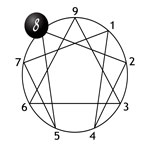
Enneagram Type Eight most exemplifies the willfulness and vitality of the Body Center. They are bold, assertive, and have a strong presence. The awake Eight has a confidence and intuition that allows for an incredible resourcefulness and drive. Eights are surprisingly sensitive and can combine their strong presence with a loving heart. They have abundant energy and use it to enact change or leave an impact on others. There’s an expansive quality to Eights.
Eights resist anything they perceive as potentially having power over them, and gradually begin to fear being controlled. In response, they shut down contact with their heart, prioritizing self-protection. They become more authoritarian while over-concerned with self-sufficiency and independence. Their natural energy turns into compulsive pushing against things. They become fearful of being taken advantage of and can become confrontational, interpreting everything as a test of wills, and manipulating others. Distressed Eights become controlling, domineering, and ruthless.
Passion: Lust - Lust is not sexual lust; instead, it is chronic intensification. Lust is the reaction to a sense of deadening of the heart experienced by shielding oneself from contact with oneself or others. Unable to make vulnerable contact of the heart, pushing for intensity becomes the antidote to inner numbness. Amping the intensity of our interactions with the environment and others provides a false feeling of being strong and real.
Fixation: Objectification* - Lust results in Eights being unable to experience the depth and realness of themselves and others. Objectification creates a sense of the self as being merely an object pushing against other objects, rather than real experiences or people.
Type Eights find their way back to essence when they recognize how their attempts to bring energy and to escalate intensity are actually creating hardness and numbness, which alienates them further from the vitality they seek. By seeing that nothing is genuinely reaching them and that this stems not from strength but fear, they can allow themselves to feel the toll this takes on their hearts. Gradually, they can trust that their own being has the Essential Power and substance to be touched by their experience in all three centers without being harmed or disempowered.
Enneagram Type 9
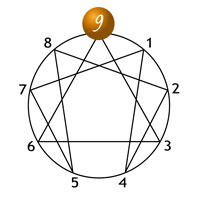
Enneagram Type Nines most exemplify the groundedness and connectedness of the Body Center. They tend to be harmonizers and are naturally empathetic and holistic thinkers. They have a quality of acceptance and gentle receptivity but may also have a strong creative or intellectual bent. Their deep sensitivity, however, means they are easily overwhelmed both by others as well as by their own internal states.
In seeking stability within and among their connections, they can resist the arising of visceral physical energies and giving attention to their own preferences. This means they don’t allow all of themselves to be fully engaged and present, repressing aspects of their self-expression and disconnecting them from the full expression of their needs, preferences, and personal value.
In these circumstances, a Nine inevitably begins to “lose themselves” and can feel neglected by others. Life comes to be seen as demanding, and to resist being tossed around, Nine's become stubborn, passive aggressive, and going along with things they may not agree with. They resist their own inner drives and passions and direct more energy toward fantasy, temporary comforts, and distractions. At the same time, they can become fearful of expressing their own powerful rage, which can boil over. As they become more fixated, they become repressed, numb, and seemingly catatonic.
Passion: Sloth - Sloth refers not to laziness, but to a resistance to fully showing up, to fully accessing one's vitality and potential as a kind of self-neglect. It manifests as resistance and disengagement - trying to stay unaffected and diffused, unable to fully engage with one’s vitality and life, a sense that there is no one home in one’s own center. The core of sloth is a feeling of "I don't really matter."
Fixation: Rumination/Fantasizing* - Nines withdraw into their imagination, escaping engagement in the world by focusing on philosophies, fantasies, distractions, nostalgia, or leaning on others to give them direction and preferences while neglecting their own value, preferences, and significance. This can create a false sense of harmony and connection while actually having little relationship to reality, like escaping into a dream.
Type Nines find their way back to essence by recognizing that their personality believes that to participate in harmony they must suppress and compartmentalize parts of themselves. If they can see this, they can practice feeling and sensing their physical presence, becoming more solid in the body, and they can see how they’ve been cutting themselves off from the connections they seek by only showing up partially. They can begin to accept and allow all their own reactions, emotions, and feelings that they previously felt would prevent them from connecting to a larger whole which can provide a direct sense of Essential Harmony.
Enneagram Type 1
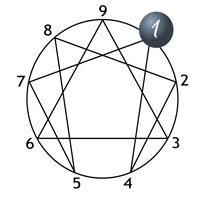
Enneagram Type One most exemplifies the integrity and alignment that comes from being present in the body. Ones tend to be principled and concerned with matters of integrity, goodness, excellence, and virtue. Most Ones have a sense of purpose or mission, and they generally have a high standard of excellence, which can be standards of ethics and fairness, but can apply to aesthetic or intellectual excellence.
But in pursuit of living up to their ideals, they begin to fear their own gut impulses might reveal that they are flawed, even corrupt. As they become less balanced, they become more rigid, self-controlled, and self-critical as well as more critical of others. Ideals become standards by which to judge others, and the distressed One comes to feel they're the only responsible person. Opinions become judgments that unconsciously support the One’s sense of ego boundaries. They increasingly become frustrated, even angry, that things are not as they think they should be, becoming intolerant, perfectionistic, and punitive.
Passion: Anger - Anger is a frustration and resentment that things are not as they ought to be which stems from a deeper grief over a perceived loss of goodness or sacredness in the world. As an alternative to collapsing in grief, the One charges themselves with anger. It ultimately amounts to resisting reality by standing too firmly in one's positions and opinions, reinforced with anger and outrage, and “arguing” with the way the world is.
Fixation: Judgment - Ones come to believe in their anger, and as a result convince themselves that reality, themselves included, is broken and in need of improvement and redemption. Ones will then live from a sense of mission, only to find reality won’t conform to their ideals, thus becoming angrier and more frustrated.
Type Ones find their way back to essence when they can relax some of the tension in their bodies. This allows them to get in touch with the grief and sadness that’s under their frustration. By allowing themselves to grieve, they can get in touch with a sense of inner spaciousness through which their fixed perspectives can see a bigger picture and their grief can be transmuted into a mercy for all the imperfections. This aligns them with a sense of their own innate goodness, Essential Integrity, rather than living their lives out of judgmental reactions to whatever is failing to live up to their standards.
The Heart Types: Two, Three, and Four
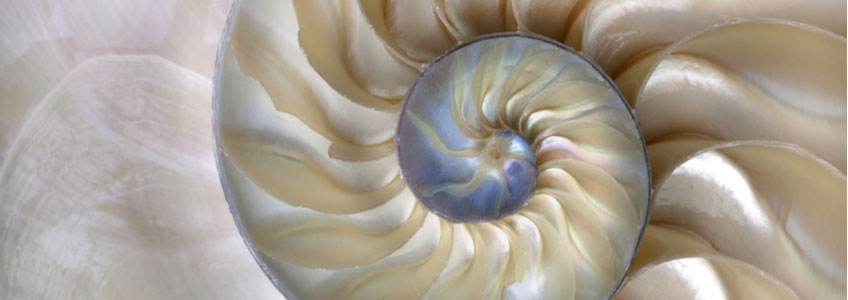
Enneagram Type 2
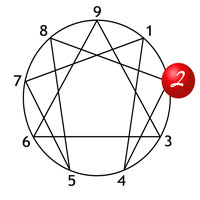
Enneagram Type Two represents the personal contact and relational intelligence of the heart. Awake Twos are altruistic, deeply loving, and giving from a place of humility and sensitivity to needs. They tend to be warm, attentive, and have a lot of energy for relationships.
Twos feel that in order to be lovable, they need to be good and loving -- but to an unrealistically high standard. But to gain others' love and to maintain the view to themselves that they are worthy of love, they begin to push their complex motivations and needs out of their awareness for fear of being “selfish”.
As fear causes Twos to lose sight of their worth, they "lean in" to others, providing attention and nurturing with the hopes of eliciting care and love in return. They become highly invested in being seen as lovable and try to draw attention to their virtue and loving acts while overlooking or denying their self-interest. They then feel they can only get their needs met in indirect, manipulative, duplicitous ways that don’t contradict the idealized self-image. As Twos become unhealthy, they begin acting in ways that can be seen as manipulative, possessive, or intrusive, yet always using "good intentions" as a justification for their behavior.
Passion: Pride - Pride is the heart’s self-rejection, based on a sense that possessing basic human needs and motivations will exclude oneself from being worthy of love. Therefore, Twos deny that they have certain unfavorable qualities, avoid “selfish” feelings, and project their own needs onto others. This obscures their own motivations and complex feelings from themselves.
Fixation: Ingratiation* - In seeing love as only coming from others, Twos spend their mental energy thinking about others, relationships, and how to win the favor and love of others. Keeping attention occupied on others keeps the Two’s motivations opaque to themselves.
Type Twos find their way back to essence by learning to invest some of the energy they readily direct to others back to themselves. When they can become genuinely interested and curious about themselves, for their own sake, they can recognize that their own needs, complex emotions, and attitudes are not conscious choices. They are just parts of the Two’s own psyche expressing itself. When they take their personality less personally, they can respond to whatever arises in their own inner life with impartiality and the quality of responsiveness and care that they so readily offer to others. This helps the Two feel that the Essential Love they seek is not conditional because they can offer it to themselves unconditionally.
Enneagram Type 3
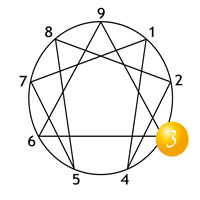
Enneagram Type Three represents the innate sense of value that comes from a connection with one’s heart and identity. Threes intuitively see value and potential in themselves and others. They use their considerable gifts, talents, and energy to make sure that potential is reached.
Threes tend to be very motivated, skillful, and adaptable, but Threes typically have internalized a sense of what value and success “looks like” from their family and culture and try to be an exemplar of that. In attempting to live up to values derived from sources other than their own heart, Threes begin to have a split between their authentic feelings and values and their public persona.
In order to function at their high level, Threes can lose touch with what’s in their heart, including the true sense of who they are. They may begin to chase success, becoming inauthentic, narcissistic, and competitive. The truly distressed Threes lose sight of who they are apart from the "mask" of their image, becoming ruthless and cold in their attempts to prop up their fragile identity.
Passion: Vanity - Vanity is abandoning one’s own heart by supporting and developing the self-image at the expense of attending to one’s inner life. Vanity is mistaking the self-image or ego for one’s being, and thus developing and attempting to make the ego feel valuable at the expense of the authentic heart.
Fixation: Deceit - In mistaking the persona for the true self, Three’s attention becomes preoccupied with doing and being that which is thought to add value to it. Ways to create and optimize value and fantasizing about how they will feel when their goals are achieved comes to dominate their thinking.
Type Three finds their way back to essence by slowing down and having patience with their own heart. Rather than waiting for the heart to reveal itself like checking in with a partner at a business meeting, Threes can give their own hearts the space and time to show up, bringing them greater connection to a sense of purpose that comes directly from themselves instead of from the outside. This provides a shift in orientation from doing and functioning, to allowing and being, that naturally awakens them to a sense of Essential Value that is inherent to the present and not based on any activity or result. This way, what they do becomes connected to who they are.
Enneagram Type 4
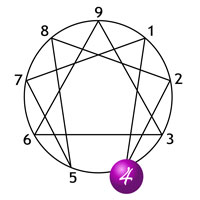
Enneagram Type Four represents the individuality and depth of the heart. Fours tend to be artistically creative, original, and idiosyncratic and they’re focused on knowing and expressing the dimension of their identity that is independent of their environment, upbringing, or any external influences - on what is uniquely their own. Because of this, Fours are highly introspective and individualistic, and they gravitate toward the symbolic, melancholic, and darkly beautiful.
In seeking to know and express their specific individuality, they become overly attuned to their moods, preferences, and subjective impressions to the point of being self-absorbed and self-limiting. The practical demands of life begin to feel at odds with their inner concentration, so they double down by rejecting the ordinary as shallow and artificial while at the same time, asserting their identity through a highly specific aesthetic and image. They become moody, frustrated, and disdainful as nothing is able to reflect or meaningfully relate to their unique identity, generating a sense of alienation and even self-hatred.
Deeply entranced Fours become self-indulgent, highly self-important, unable to function, turbulent, and lashing out with hatred toward loved ones and against themselves.
Passion: Envy - Envy is a chronic sense of inner lack that results from drawing one’s identity from the personality, which is a structure and therefore without depth or authentic individuality. This leads to a deep frustration and rejection of anything and anyone that doesn’t accord with their highly specific tastes and needs.
Fixation: Melancholy - Envy leads to an outlook in which everything is viewed as disappointing and deeply hopeless. Fours’ minds become occupied with dark thoughts that unconsciously function to keep their negative emotional states charged up, replaying stories or imagining scenarios that stir up feelings of deficiency, longing, or of being particularly flawed. This inner spectacle distracts them from practical action, which, in turn, reinforces the sense of hopelessness and deficiency.
Type Fours can find their way back to essence by grounding themselves in the body and in physical activity. This brings them out of their stormy emotional-conceptual loops and being in touch with physical sensation gives them a direct experience of their own separateness and sovereignty that doesn’t have to be reinforced through psychological patterns. Being in the body also gives them a sense of capability to function in the world and a basic sense of contact with themselves outside emotional reactions that counters their sense of alienation that comes from living too narrowly inside themselves. By adding the physical dimension to their experience, they’re able to come into contact with a sense of Essential Depth that doesn’t come from pushing anything away, but from deeply being in contact with the present moment.
The Mental Types: Five, Six, and Seven
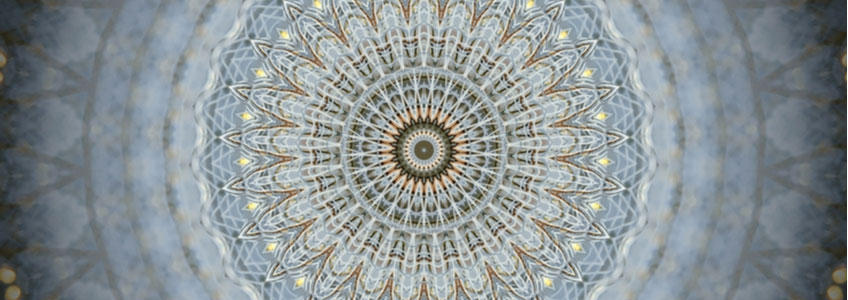
Enneagram Type 5
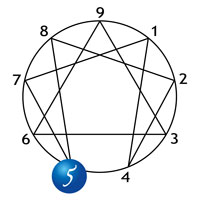 Enneagram Type Five represents the insight, vision, and fascination of the mind. Fives have a deep capacity for concentration that they combine with creative imaginations and an ability to extract insights from complex subject matter. Fives are not generalists. When their curiosity is piqued, they become voraciously consumed by their topic of interest, with a drive to discover original insights.
Enneagram Type Five represents the insight, vision, and fascination of the mind. Fives have a deep capacity for concentration that they combine with creative imaginations and an ability to extract insights from complex subject matter. Fives are not generalists. When their curiosity is piqued, they become voraciously consumed by their topic of interest, with a drive to discover original insights.
Despite their penetrating focus and high-strung energy, Fives have thin psychological boundaries, so they can easily feel overwhelmed by dealing with anything outside their fascinations. The outer events become a distraction, and they begin to prioritize their conceptual world above all else.
As they become imbalanced, Fives fear they aren't adequately prepared to meet the demands of life. They become anxious and withdraw to try to gain more distance and perspective, making them more paralyzed and less spontaneous. They will try to think their way through everything, becoming alienated, high strung, out of touch with their body and emotions, and defending themselves intellectually with arrogance and condescension. A truly fearful Five becomes schizoid, overwhelmed, shut down, and totally absorbed in their own mental world.
Passion: Avarice - Avarice isn’t material greed, but a kind of greed of self that stems from a feeling they are too insubstantial, incapable, and unequipped to have a presence in the world. It stems from the ego’s basic sense of lacking the inner resources to deal with life and other people. This creates for Fives a fear of depletion that in turn leads to a great deal of control around who can access them, preciousness around what they give their attention to, and flat out disengaging with whatever doesn’t interest them while simultaneously grasping for insights.
Fixation: Retention* - Retention is the preoccupation with greedily acquiring and stockpiling skills, knowledge, and information in the hopes of generating a sense of being equipped to deal with the overwhelm of life. Mental activity is occupied with penetrating focus on certain topics while completely directing attention away from others.
Type Fives find their way back to essence when they understand that engagement with experience that includes the body doesn’t stifle one’s ability to discover and yield insight, but actually makes for a means of knowing in a way that complements and rounds out the knowing of the mind. By stepping into sensation and activity, Fives’ experience of themselves and the world becomes less conceptual, and they’re able to obtain a kind of trust and confidence in their capacities to be involved in life. This can be taken as a kind of awakening of Essential Insight through new means of knowing, seeing, and being.
Enneagram Type 6
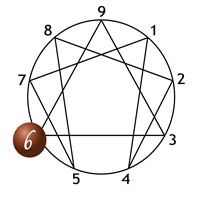
Enneagram Type Six represents the devotion to truth, attentiveness, and inquisitiveness of the awake mind. Sixes have a gift for foresight and practical intuition. They are typically funny, curious, loyal, and have a rebellious streak. Sixes are focused on discerning what’s true, real, authentic, and on finding clarity.
Sixes typically have a strong sense of responsibility and are tenacious supporters of whatever they care for, but because their sense of loyalty is so powerful, they also adopt a protective vigilance and skepticism. This attentiveness makes them keenly aware of inconsistencies, contradictions, and vulnerabilities.
In seeking to manage life’s ambiguities, they rely too much on their minds to reason through problems and anticipate outcomes. This develops into chronically overthinking their choices and convictions. In turn, they feel unequipped to handle things on their own and look for stabilizing and supportive structures outside themselves - these can be relationships, systems, or beliefs. They become plagued by anxiety and can overthink to the point of undermining their actual supports and may adopt extreme beliefs that act as a kind of false certainty. When deeply unhealthy, they become panicked, paranoid, defensive, and destructive.
Passion: Fear - Fear isn’t cowardice, but a terrifying sense that everything is fraudulent and that one has been abandoned to a chaotic universe. This leads to a lack of confidence in their capacity to make sound decisions and move forward independently and the projection of a pervasive sense of anxiety onto their experience.
Fixation: Worry* - Worry is the preoccupation with evaluating what is and isn’t trustworthy, trying to anticipate what could go wrong, while undermining whatever security is already present with doubting and overthinking. Sixes caught in worrying attempt to organize their environment so as to make it more predictable and less threatening, while constantly second guessing their choices, actions, and environment.
Sixes find their way back to essence when they can have the courage to relax some of their intense mental strain and search. When Sixes can recognize that they’ve been handling things throughout their lives thus far, they can trust in their own inner resourcefulness, guidance, and new ways of knowing that arise from inner spaciousness. Combining alertness with relaxation, they can take ownership of their actions, choices, and even mistakes, seeing that these are not only in alignment with Essential Truth but are actually expressions of it.
Enneagram Type 7
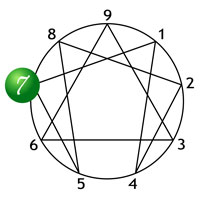
Enneagram Type Seven represents the versatility and freedom of the awake mind. Sevens tend to be mercurial, adventurous, and optimistic. They are in love with possibilities and tend to jump into new situations or learn new skills with ease. Sevens are naturally spontaneous, energetic, and delight in having a variety of experiences.
They make pleasure a priority, but in attempting to keep experiences and enjoyment going, Sevens will gloss over “limiting” feelings of deprivation, grief, sadness, and boredom. Boredom in particular produces a great deal of anxiety for Sevens. To avoid these anxieties, they will mentally “jump ahead” of whatever comes next.
As they become imbalanced, they lose touch with what will be satisfying for them and become occupied with anticipation. As restlessness and impatience mounts, they become addicted to the sense of novelty, acquisition, discovery, and beginnings, but get lost in ever-bigger plans, crazier experiences, and exhaustion. Sevens become scattered, flakey, and avoidant of pain, grief, and emptiness. Fearful of missing out on something and unable to know what can satisfy them, very unhealthy Sevens finally become indulgent, reckless, panic-stricken, and callous towards that which doesn't gratify them.
Passion: Gluttony - Gluttony is a sense of deprivation and an inability to know precisely what can satisfy. It’s the ego’s attempt to fill an emptiness inside with experiences instead of the essential life the heart craves. Gluttony propels Sevens into experience after experience without properly "digesting" and can be characterized by an impatient, burning frustration.
Fixation: Anticipation - Anticipation is the conviction that all that’s desirable exists outside of oneself, creating a false sense of excitement that covers fear and feelings of deprivation. The mind becomes occupied with planning, multitasking, and distractions.
Type Sevens find their way to essence when they can recognize that in their attempts to not miss out on anything, they’re actually missing some of the most valuable parts of their experience. If they can release some of the anxiety fueling their mental activity, they can take in their experience through the heart in addition to the head, which entirely shifts their sense of what it means to have an experience. With the heart involved, they can find a sense of satisfaction they couldn’t anticipate. This brings a recognition that satisfaction doesn’t come through what we experience, but how we experience. Essential Freedom is not about the outer conditions of events. It is our capacity to be fully with an experience without having to produce anything or go in search of anything.

Your Enneagram Journey
It’s easy to get lost in all this information, but it’s important to have patience with the Enneagram. Modern life has primed us to expect quick results and clear, simple answers, but the process of finding one’s type and learning the Enneagram requires studiousness and humility rarely found or encouraged today. It’s more than likely that the first result from an Enneagram test or the type we initially think we are not actually our genuine type - a testament to how layered and unconscious our personality is. The value knowing our Enneagram type brings is in seeing all the places where we’re asleep and lost in identification. In inner work, it does us no good to lift ourselves up for how awake and conscious we are. Growing in consciousness is, paradoxically, seeing more deeply how lacking in true consciousness we are. The Enneagram is one of the best tools for that.
Most of us are somewhat dissociated from our bodies, out of touch with our authentic feelings, and mentally engaged in distractions and delusions. We didn’t sign up for these patterns and habits. Seeing this, we can have compassion for ourselves and have the willingness to look at parts of ourselves that may be unflattering, embarrassing, unhealed, and distasteful with the recognition that none of us chose to be our Enneagram type.
The Enneagram teaches us that our egoism, our “falling asleep,” and the difficulty of awakening is not the problem. It is our lack of effort to simply be present in body, heart, and mind and not taking the need to be present seriously enough that is the problem. By seeing how we are “asleep,” we can awaken to what’s important and return to our physical sensation, our feeling, and our perception over and over again.
 About the Author: John Luckovich is an artist who lives in Brooklyn, NY. He has studied the Enneagram for over a decade. He has a deep involvement in the Fourth Way, an interest in the Egyptian roots of Western spirituality, and six years of training in Integrative Breathwork. John is the author of The Instinctual Drives and the Enneagram. He is also the co-host of The Big Hormone Enneagram Podcast and the co-founder of New York Enneagram. John offers Enneagram coaching, leads workshops, retreats, and Inner Work-based pilgrimages to Egypt. His work can be found at johnluckovich.com.
About the Author: John Luckovich is an artist who lives in Brooklyn, NY. He has studied the Enneagram for over a decade. He has a deep involvement in the Fourth Way, an interest in the Egyptian roots of Western spirituality, and six years of training in Integrative Breathwork. John is the author of The Instinctual Drives and the Enneagram. He is also the co-host of The Big Hormone Enneagram Podcast and the co-founder of New York Enneagram. John offers Enneagram coaching, leads workshops, retreats, and Inner Work-based pilgrimages to Egypt. His work can be found at johnluckovich.com.
